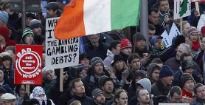Irish Protest Budget Cuts
After a week that brought Ireland a pledge of a $114 billion international rescue package and the toughest austerity program of any country in Europe, tens of thousands of demonstrators took to Dublin’s streets on Saturday to protest wide cuts in the country’s welfare programs and in public-sector jobs.
The protests centered on a milelong march along the banks of the River Liffey in central Dublin to the General Post Office building on O’Connell Street, the site of the battle between Irish republican rebels and British troops in the Easter Uprising in 1916 — an iconic event that many in Ireland regard as the tipping point in Ireland’s long struggle for independence.
The choice of venue for the protests by the Irish Congress of Trade Unions, coordinating the march through the city, reflected the mood of anger, dismay and recrimination in the wake of the economic shocks of the past 10 days. Those shocks have been the culmination of two years in which the economy has shrunk by about 15 percent, faster than any other European economy.
Before that, Ireland enjoyed more than a decade of unprecedented prosperity, so the rescue package being worked out by the International Monetary Fund and the European Union and the austerity program the Dublin government has been forced to adopt to secure the bailout loans have come as a deep jolt.
Among other things, the austerity package will involve the loss of about 25,000 public-sector jobs, equivalent to 10 percent of the government work force, as well as a four-year, $20 billion program of tax increases and spending cuts like sharp reductions in state pensions and minimum wage. One Dublin newspaper, the Irish Independent, estimated that the cost of the measures for a typical middle-class family earning $67,000 a year would be about $5,800 a year.
The ensuing political turmoil has raised questions about the ability of the government of Prime Minister Brian Cowen to secure backing for the austerity package when it is presented to Parliament on Dec. 7. The coalition government was weakened last week by a split between the Fianna Fail party, which Mr. Cowen leads, and its main coalition partner, the Green Party, and a stunning loss by Fianna Fail in an election on Friday for a parliamentary seat that reduced the government majority to two.
The mostly peaceful and restrained nature of the protests on Saturday was one indication that the unrest may not lead to confrontations in the streets, as some have feared. On a bitterly cold day, organizers put the turnout at 100,000. The police estimated 50,000, still one of the largest protest gatherings in years.
Click here to read more.


